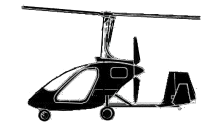
ASN Wikibase Occurrence # 278314
This information is added by users of ASN. Neither ASN nor the Flight Safety Foundation are responsible for the completeness or correctness of this information.
If you feel this information is incomplete or incorrect, you can submit corrected information.
| Date: | Sunday 22 May 2022 |
| Time: | 08:03 |
| Type: |  Magni M24 Orion Plus |
| Owner/operator: | Private |
| Registration: | N590DM |
| MSN: | 24213475 |
| Year of manufacture: | 2022 |
| Fatalities: | Fatalities: 1 / Occupants: 1 |
| Aircraft damage: | Substantial |
| Category: | Accident |
| Location: | Cape Girardeau Regional Airport (CGI/KCGI), Cape Girardeau, MO -
 United States of America United States of America
|
| Phase: | Take off |
| Nature: | Private |
| Departure airport: | Cape Girardeau Airport, MO (CGI/KCGI) |
| Sioux Falls, SD | |
| Investigating agency: | NTSB |
| Confidence Rating: |
On May 22, 2022, about 0803 central daylight time, an experimental amateur-built Magni M24 Orion Plus gyroplane, N590DM, was substantially damaged when it was involved in an accident near Cape Girardeau, Missouri. The private pilot was fatally injured. The gyroplane was operated as a Title 14 Code of Federal Regulations Part 91 personal flight.
The pilot was ferrying a gyroplane from Gulf Shores, Alabama, to his home in South Dakota. He made an overnight stopover in Cape Girardeau, Missouri, as part of his planned route of flight. The following morning he requested progressive taxi instructions from air traffic control to the assigned departure runway. After he taxied to the runway he departed to the northwest, consistent with what he told the controller. However, shortly into his climb, he reported to the controller that he wanted to return to the airport and the controller cleared him to land on his departure runway. The gyroplane flew the airport traffic pattern back to the runway to land; however, during the downwind leg the gyroplane rapidly descended to the ground following a loud crack that was heard by a witness at the airport.
Postaccident examination of the gyroplane revealed no preimpact mechanical anomalies or malfunctions with the airframe or engine that could have precluded normal operation. Data retrieved from an onboard recording system suggests that the engine performance was unremarkable and consistent with the throttle movements throughout the final moments of the flight. Paint transfer marks on the rotor blades suggested that the main rotor contacted the horizontal stabilizer right winglet in the final moments of the accident flight, which was likely the source of the “crack” sound heard by the witness.
The postaccident examination revealed evidence of severe blade flapping from a partial bend of the teetering stop of one of the main rotor blades and rotor contact with the horizontal stabilizer, which is typically due to a several-second low g or zero rotor load condition that slows the autorotation speed of the rotor. This condition was likely the result of the 270° hard left roll before the gyroplane rapidly descended and impacted the ground. Without the ability to maintain a load on the rotor in the full roll over, the rotor would have slowed and began severe flapping.
The investigation was unable to determine the reason for such a severe control input (hard left roll) based on the available evidence. The evidence does indicate distress in the pilot’s voice and that he had opened his door at some point during the flight. There was no damage to the door latches and the door was found at the same distance from the main wreckage as the right horizontal stabilizer (about 170 ft). As a door annunciation would have informed the pilot if the door was not properly latched on takeoff, it is likely that this occurred in flight, and was possibly intentional if the pilot anticipated a hard landing.
The accident was the result of the pilot’s failure to maintain controlled flight, which resulted in a hard left roll, excessive blade flapping, and a subsequent inflight separation of the right horizontal stabilizer.
Probable Cause: The pilot’s failure to maintain controlled flight, which resulted in a hard left roll, excessive blade flapping and a subsequent in-flight separation of the right horizontal stabilizer.
Accident investigation:
 |
|
Sources:
https://www.kfvs12.com/2022/05/22/helicopter-crash-cape-girardeau-airport-leaves-one-hospitalized/
https://data.ntsb.gov/Docket?ProjectID=105112
https://registry.faa.gov/AircraftInquiry/Search/NNumberResult?nNumberTxt=N590DM
Location
Images:

Photo: NTSB
Media:
NTSB investigating the 5/22/22 crash of an
— NTSB Newsroom (@NTSB_Newsroom) May 22, 2022
experimental M24 Orion Plus gyrocopter near Cape Girardeau, Missouri.
Revision history:
| Date/time | Contributor | Updates |
|---|---|---|
| 22-May-2022 19:09 | Captain Adam | Added |
| 22-May-2022 19:43 | harro | Updated [Total fatalities, Other fatalities, Embed code, Narrative] |
| 23-May-2022 20:28 | RobertMB | Updated [Time, Aircraft type, Registration, Cn, Operator, Phase, Nature, Destination airport, Source, Narrative] |
| 23-May-2022 21:22 | Captain Adam | Updated [Total fatalities, Narrative] |
| 09-Jun-2022 08:20 | Captain Adam | Updated [Time, Phase, Departure airport, Destination airport, Source, Narrative] |
| 10-Apr-2024 23:19 | Captain Adam | Updated [Location, Destination airport, Source, Narrative, Accident report, Photo] |
Corrections or additions? ... Edit this accident description
The Aviation Safety Network is an exclusive service provided by:


 ©2024 Flight Safety Foundation
©2024 Flight Safety Foundation